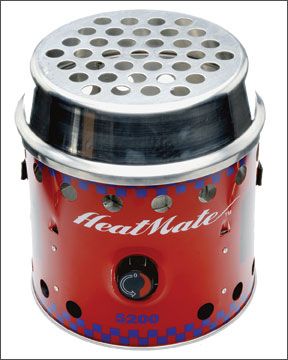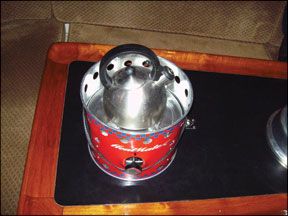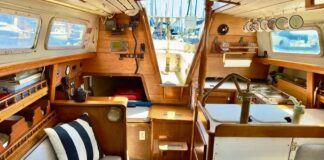When temperatures decrease, the search for viable heating options by shivering sailors invariably increases. A recent cold winters night provided the perfect opportunity for one blue-nosed liveaboard Practical Sailor tester to check out the HeatMate 5200 heater-stove from Contoure International Inc.

The HeatMate 5200 is a portable, non-pressurized alcohol heater that easily converts into a stove. Weighing in at about 5 pounds, the fairly compact, aluminum unit measures approximately 11.75 inches tall by 11.5 inches in diameter, and it comes assembled and ready to go.
The HeatMate comprises five parts, the heater can (body), heater lid, fuel canister, burner assembly, and flame spreader. The detachable fuel canister contains a non-flammable wick material, which uses natural capillary action to pass fuel (alcohol vapor) to the heaters single burner. The beauty of this system is that there is no risk of fuel leaks should the unit tip over or even turn completely upside down.
The HeatMate has an advertised output of 5,200 BTU with the “thermostat” being a horizontal damper, which slides over the throat of the fuel canister, limiting the size of flame.
The HeatMate easily converts into a stove by simply removing the heater lid and flame spreader. We placed a quart of water in a standard teapot and had water hot enough to make a cup of coffee in roughly 11 minutes, with a rolling boil achieved in just less than 17 minutes.
The fuel canister holds approximately 1 quarts (about 5 cups) of alcohol and will last approximately seven hours with the heater on high (just about right for a good nights sleep) but will of course last longer with the flame reduced.

Although relatively inexpensive and widely available, there are a few disadvantages associated with alcohol fuel. Alcohol generates less heat per unit compared to other fuels like propane or diesel, and it is considered to be a “wet” fuel, meaning condensation inside a cold cabin could be an issue, making good ventilation a must.
Disadvantages of the HeatMate are that fueling can be messy and the heater must be completely cool before refueling. Alcohol fires can be extinguished with water, but the downside is that doing so can sometimes spread the flames. Care should be taken when using any flame-fired appliance. Flames deplete the air of oxygen, so a port or hatch should always be left open to aid ventilation.
Construction and operation of the HeatMate, which is distributed by InterCon Marketing, is similar to the well-known Origo Heat Pal 5100 alcohol heater, which was formerly distributed by InterCon. Practical Sailorreviewed the Origo in the Oct. 15, 2003 issues look at onboard heating options. We had the same pros and cons list for it as we do for the HeatMate: Pros include portability, simplicity, and price. Cons include the alcohol smell (higher-grade fuel has less odor, however), condensation, and a reluctance to use it unattended underway.

However, the Contoure HeatMate is less expensive than the Origo: It can be found online for $100, compared to the Origos $140.
The day we put the HeatMate through its paces our tester arrived onboard a snow-covered boat with outside temps in the upper 30s. After 30 minutes of operation, the HeatMate had knocked the chill from the approximately 500-square-foot cabin. Our tester measured 278 degrees on the surface of the heater. The cabin wasnt hot by any stretch of the imagination, but the temperature was comfortable enough that the tester needed to wear only a fleece pullover.
The HeatMate worked well, but as the evening progressed and outside temps fell into the mid 20s, the tester needed to fire up two portable, fan-assisted electric heaters to bring the cabin to a comfortable temperature.
Bottom line: The HeatMate is a well-built unit that performs well. Pricing and good quality construction make it a viable option to keep the chill at bay during those late fall or early spring outings, but at the dock convenience and ease of use make electric heaters hard to beat. Off the grid, a built-in heating system is the best option for cruisers frequently in cold climates.






































